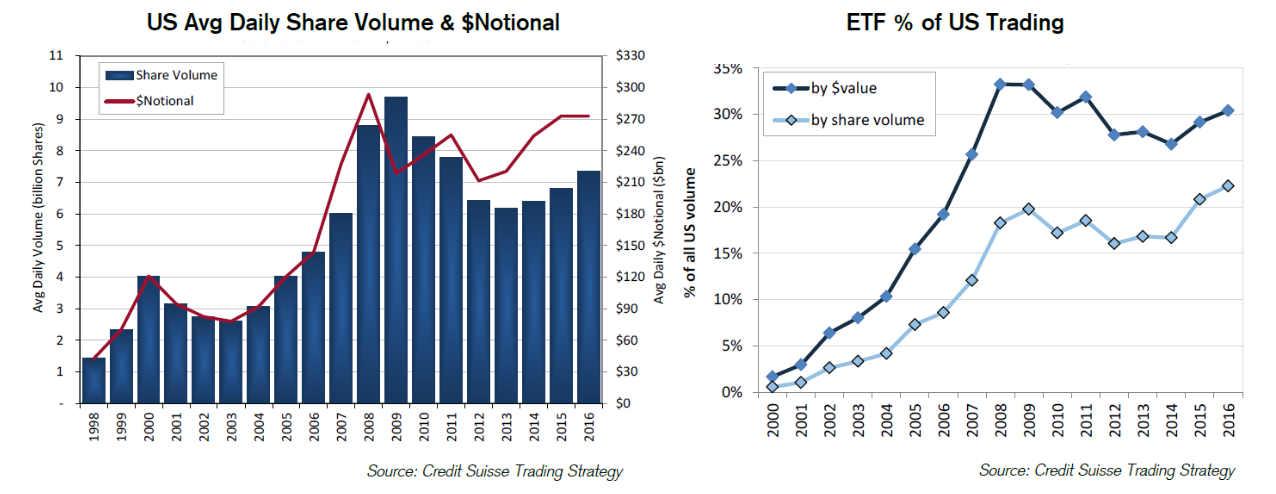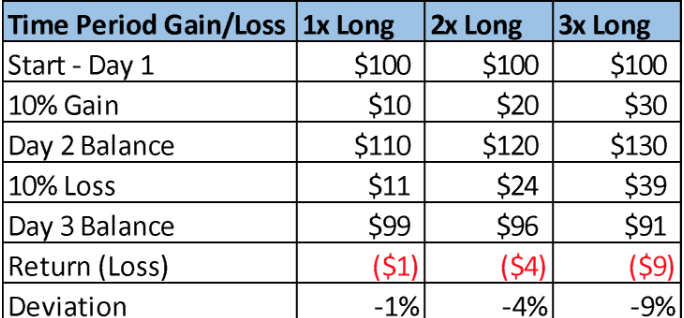The post How to Invest in ETFs: A Beginner’s Guide by Jay and Julie Hawk appeared first on Benzinga. Visit Benzinga to get more great content like this.
Invest in ETFs today with Interactive Brokers or Robinhood as your trusted brokerage.
Burned by the recent meme stock craze? Had a few “to the moon” stock picks come crashing down? Sick of being charged high fees by a financial advisor for mutual funds? Well, there’s a simple solution to all of that via investing in exchange-traded funds (ETFs).
Exchange-traded funds (ETFs) currently make up nearly one-third of all U.S. trading by dollar value and nearly a quarter of all share volume. That’s pretty amazing for a product that has only been around since the 1980s and didn’t really “show up” until the middle-to-end of the last decade.
These versatile investment instruments offer beginners a straightforward, transparent and low-cost introduction to investing. If you’re looking to revamp your portfolio by investing in ETFs, then this guide is for you.
Table of contents
[Show]
ETFs at a Glance
ETFs are mutual funds that can be bought and sold during the trading day at the current market price, while mutual fund shares are redeemed at the end of the day based on the net asset value (the worth of the fund’s portfolio at closing prices).
Other key ETF factors include:
- ETFs must disclose holdings daily while active mutual funds do it quarterly or semi-annually.
- Unlike mutual funds, ETFs are less likely to have taxable events, making them more tax efficient.
- ETFs come with stock transaction costs whereas mutual funds may or may not have any transaction costs.
- ETFs are generally based on indexes rather than active management or complex strategies.
Typically, you’ll see ETFs cover sectors like healthcare and technology or commodities like gold and crude oil, or simply track an overall index (like the popular NYSEARCA: SPY on the S&P 500). However, there are some exotic ETFs that use leverage or track the inverse of an index.

Types of ETFs
The different types of ETFs can be broadly distinguished by their asset class, geography and strategy. Asset class refers to whether the ETF tracks stocks, bonds, commodities, currencies or derivatives. Geography refers to which country the ETF’s assets originate from. Strategy refers to the management style of the ETF, which is usually passive versus active. These categories are not mutually exclusive, with many ETFs having characteristics of each one. Here are some common types of ETFs.
Index ETFs
Index ETFs are passive investments that try to replicate and track the performance of a stock market index, such as the S&P 500, Nasdaq 100 or the Dow Jones Industrial Average. They can also track proprietary indexes created by various organizations like S&P Global, FTSE or MCSI. Indexes can target stocks, bonds, commodities or currencies from around the world. Because of their low turnover and automated nature, index ETFs tend to charge lower fees.
Active ETFs
Active ETFs do not track an index. Rather, they use their own quantitative or qualitative strategies with the objective of outperforming a benchmark or fulfilling a specific objective. Examples include ETFs that target potentially undervalued stocks based on a quantitative screener or ETFs that use options strategies to try to provide higher-than-average yields. These ETFs generally have higher expense ratios than their index counterparts.
Leveraged/Inverse ETFs
Leveraged/Inverse ETFs are special types of active ETFs that provide enhanced exposure to an underlying asset. For example, a 2x leveraged S&P 500 ETF might target a daily return double that of the S&P 500, while an inverse S&P 500 ETF might target a daily return opposite that of the S&P 500. Both leveraged and inverse ETFs are considered advanced tools best suited for short-term traders. These ETFs can behave unpredictably when held long term and are highly volatile. They also tend to have high expense ratios.
Country ETFs
Country ETFs provide investors with exposure to stocks and bonds listed on the exchanges of a specific country. For example, a total U.S. stock market and total U.S. bond market ETF would provide investors with exposure to U.S. stocks and U.S. bonds respectively. These ETFs can be combined in various proportions to provide global market exposure.
Equity ETFs
Equity ETFs only hold stocks. The actual selection of the stock depends on both the strategy of the ETF and its geography. For example, a passive U.S. index ETF might have substantially different holdings that an active U.S. low-volatility ETF. Equity ETFs can further be distinguished by the sector of their holdings, such as technology, consumer staples and healthcare to name a few.
Bond ETFs
Bond ETFs only hold fixed-income assets. Like stocks, they can be sorted based on their strategy and geography. An example would be a passive U.S. bond index ETF versus an active Canadian unconstrained bond ETF. Bond ETFs can further be categorized by the types of bonds they hold. Just like how stocks can come from different sectors, bonds can come from different issuers (government vs. corporate), credit quality (investment grade vs. junk) and maturities (short, intermediate or long durations).
Commodities ETFs
Some ETFs track commodities, which include resources like gold, silver, copper, oil, natural gas, soybeans, corn and wheat. Commodities ETFs can come in passive index and actively managed variants. They can either be physically backed by holding the commodity directly in storage (usually gold or silver) or gain synthetic exposure via commodity futures. Commodity ETFs are usually used to speculate on commodity prices or hedge against inflation. They tend to be volatile and charge high fees.
Pros and Cons of ETFs
ETFs provide some of the best ways for retail investors to gain exposure to various sectors of the market without opening numerous accounts and oftentimes are available in self-directed retirement accounts.
Pros
- They’re open to investors. Mutual funds can sometimes close to new investors if they have limits on the amount of clients. ETFs are only limited by the number of shares available and someone willing to sell them.
- They’re liquid. ETFs are easy to buy and sell. SPY, which tracks the S&P 500, trades nearly 90 million shares on average every day
- Brokers offer commission-free ETFs. Many brokers offer commission-free ETFs that you can purchase through everything from regular trading accounts to self-directed retirement accounts. Though each broker may have a version of the same ETF, as long as they have decent liquidity they’re all roughly the same.
- They’re diversified. ETFs provide an easy way for investors to expand their product holdings and manage their own portfolios rather than relegate the authority to fund managers.
- Taxes are easier. Without getting into the gory details, the ability to trade ETFs like a stock makes it easier to do taxes and forecast them, while nuances with mutual funds can cause unexpected tax events.
- They carry relatively low fees. Since most ETFs track an index, commodity or simple strategy, they generally have low fees since they require little management.
Cons
- ETFs that invest in other countries may be limited to larger companies or a particular set of companies based on the index they track or governmental rules.
- As larger ETFs have great liquidity, some of the newer, niche or smaller ETFs do not have high liquidity. In fact, some trade as few as a few hundred shares a day.
- While an ETF that provides 2x exposure to the S&P 500 may seem straightforward, it may not be. Some of these ETFs track the daily price movements in the index, meaning they quickly decouple from the underlying index. Check out the chart below to see how the math could work out.

How to Invest in ETFs
Buying an ETF works just like a stock, here’s how to buy an ETF:
- Fees and management:
It’s worth understanding management fees, expected fees associated with buying and selling the ETF as well as the fees an ETF incurs to track its index.
- Pick a broker:
Most major brokers in the U.S. provide access to any ETF that is openly traded. Many brokerage accounts offer their own ETFs or partner with a company to provide ETFs that don’t have any trading commissions associated with them but may require a certain holding period.
- Decide how much to invest:
Once you understand what an ETF tracks as well as what it holds, you can decide how much you want to invest in an ETF. Keep in mind that if you already own Apple shares and you purchase an ETF that tracks the S&P 500, you’ll get additional exposure to Apple through that ETF.
- Purchase the ETF:
You can buy the ETF you’ve chosen during normal trading hours as you would any stock.
Check out Benzinga’s picks for the Best Brokerages for ETF Investing.
ETFs vs. ETNs
While most people use ETFs, exchange-traded notes (ETNs) are lesser known, and there are important differences:
- Fund vs. debt note: ETFs are actually funds that own the underlying assets. ETNs are debt notes issued by an institution, essentially unsecured bond guarantees to the index or asset they’re trying to track.
- Tracking error: Over time, an ETF will not match the underlying index or asset it’s tracking due to a combination of management fees and transactional fees. Example: oil ETFs lose value over time due to the cost of rolling futures contracts plus management fees. ETNs have no tracking errors other than their management fee and tax fees.
Because of these two major differences, the tradeoff between the two is risk. ETNs accept the risk of the underlying product plus that of the issuing institution. ETFs only accept the underlying product risk, but you also get tracking error.
The risk is high with ETNs, though. To date, there are no known ETFs that have closed and weren’t able to be redeemed at their net asset value. However, there are examples of leveraged crude oil products to a recent ETN issued by Credit Suisse (XIV) that crashed 80% in one day.
Best Brokerage Accounts for ETF Investing
To begin investing in ETFs you’ll need to open a brokerage account with a qualified broker. Below you’ll find Benzinga’s favorite trading platforms.
Future Outlook for ETFs
In the last decade and a half, ETFs have grown to global record levels in excess of $4.6 trillion. U.S. ETFs alone topped $3.3 trillion in 2017. The Bank of Montreal noted in its annual report that it expects the industry to continue to grow both in total assets as well as options available. The industry is projected to double to more than $10 trillion in the next five years.

Set Your Investment Objectives and Start ETF Trading
You need to do your homework to understand how ETFs actually function. Many ETFs track the S&P 500, but not all are created equal. If you compared the SPDR S&P 500 (SPY) to Vanguard S&P 500 (VOO) you’d notice that the expense ratio fees for SPY are 0.09% vs 0.04%. However, digging a bit deeper, you’ll see that SPY distributes dividends while VOO reinvests its interim cash. Nuances like these are what you’ll need to hash out.
If you are ready to start investing in ETFs, check out Benzinga’s top ETF list.
Frequently Asked Questions
Are ETFs a good investment?
Whether ETFs are a good investment depends on an investor’s objectives. In general, ETFs are good investments for passive, hands-off investors trying to construct a diversified portfolio at a low cost. For stock-pickers, ETFs may be too diversified for their needs. However, ETFs can also be a good investment for traders given their ability to hold different assets. For example, fixed-income traders can trade options on bond ETFs, and equity traders can trade options on stock index ETFs.
Are ETFs good for beginners?
ETFs are an excellent choice for beginners because of their transparency, diversification and low fees. ETFs publish holdings on a regular basis, so investors can easily see what the ETF’s strategy is and understand what the underlying assets are. Many ETFs offer high diversification, which can help beginner investors construct a portfolio that spreads out risk better. Finally, the expense ratios charged by many ETFs, especially passive index ones, help investors attain better net returns.
Can you really make money on ETFs?
Yes, you can absolutely make money investing in ETFs.
The post How to Invest in ETFs: A Beginner’s Guide by Jay and Julie Hawk appeared first on Benzinga. Visit Benzinga to get more great content like this.








